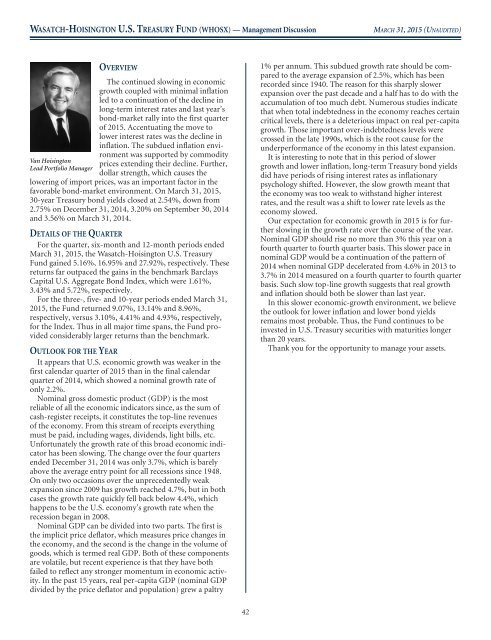WASATCH FUNDS - Curian Clearing
WASATCH FUNDS - Curian Clearing
WASATCH FUNDS - Curian Clearing
You also want an ePaper? Increase the reach of your titles
YUMPU automatically turns print PDFs into web optimized ePapers that Google loves.
<strong>WASATCH</strong>-HOISINGTON U.S. TREASURY FUND (WHOSX) — Management Discussion<br />
MARCH 31, 2015 (UNAUDITED)<br />
Van Hoisington<br />
Lead Portfolio Manager<br />
OVERVIEW<br />
The continued slowing in economic<br />
growth coupled with minimal inflation<br />
led to a continuation of the decline in<br />
long-term interest rates and last year’s<br />
bond-market rally into the first quarter<br />
of 2015. Accentuating the move to<br />
lower interest rates was the decline in<br />
inflation. The subdued inflation environment<br />
was supported by commodity<br />
prices extending their decline. Further,<br />
dollar strength, which causes the<br />
lowering of import prices, was an important factor in the<br />
favorable bond-market environment. On March 31, 2015,<br />
30-year Treasury bond yields closed at 2.54%, down from<br />
2.75% on December 31, 2014, 3.20% on September 30, 2014<br />
and 3.56% on March 31, 2014.<br />
DETAILS OF THE QUARTER<br />
For the quarter, six-month and 12-month periods ended<br />
March 31, 2015, the Wasatch-Hoisington U.S. Treasury<br />
Fund gained 5.16%, 16.95% and 27.92%, respectively. These<br />
returns far outpaced the gains in the benchmark Barclays<br />
Capital U.S. Aggregate Bond Index, which were 1.61%,<br />
3.43% and 5.72%, respectively.<br />
For the three-, five- and 10-year periods ended March 31,<br />
2015, the Fund returned 9.07%, 13.14% and 8.96%,<br />
respectively, versus 3.10%, 4.41% and 4.93%, respectively,<br />
for the Index. Thus in all major time spans, the Fund provided<br />
considerably larger returns than the benchmark.<br />
OUTLOOK FOR THE YEAR<br />
It appears that U.S. economic growth was weaker in the<br />
first calendar quarter of 2015 than in the final calendar<br />
quarter of 2014, which showed a nominal growth rate of<br />
only 2.2%.<br />
Nominal gross domestic product (GDP) is the most<br />
reliable of all the economic indicators since, as the sum of<br />
cash-register receipts, it constitutes the top-line revenues<br />
of the economy. From this stream of receipts everything<br />
must be paid, including wages, dividends, light bills, etc.<br />
Unfortunately the growth rate of this broad economic indicator<br />
has been slowing. The change over the four quarters<br />
ended December 31, 2014 was only 3.7%, which is barely<br />
above the average entry point for all recessions since 1948.<br />
On only two occasions over the unprecedentedly weak<br />
expansion since 2009 has growth reached 4.7%, but in both<br />
cases the growth rate quickly fell back below 4.4%, which<br />
happens to be the U.S. economy’s growth rate when the<br />
recession began in 2008.<br />
Nominal GDP can be divided into two parts. The first is<br />
the implicit price deflator, which measures price changes in<br />
the economy, and the second is the change in the volume of<br />
goods, which is termed real GDP. Both of these components<br />
are volatile, but recent experience is that they have both<br />
failed to reflect any stronger momentum in economic activity.<br />
In the past 15 years, real per-capita GDP (nominal GDP<br />
divided by the price deflator and population) grew a paltry<br />
1% per annum. This subdued growth rate should be compared<br />
to the average expansion of 2.5%, which has been<br />
recorded since 1940. The reason for this sharply slower<br />
expansion over the past decade and a half has to do with the<br />
accumulation of too much debt. Numerous studies indicate<br />
that when total indebtedness in the economy reaches certain<br />
critical levels, there is a deleterious impact on real per-capita<br />
growth. Those important over-indebtedness levels were<br />
crossed in the late 1990s, which is the root cause for the<br />
underperformance of the economy in this latest expansion.<br />
It is interesting to note that in this period of slower<br />
growth and lower inflation, long-term Treasury bond yields<br />
did have periods of rising interest rates as inflationary<br />
psychology shifted. However, the slow growth meant that<br />
the economy was too weak to withstand higher interest<br />
rates, and the result was a shift to lower rate levels as the<br />
economy slowed.<br />
Our expectation for economic growth in 2015 is for further<br />
slowing in the growth rate over the course of the year.<br />
Nominal GDP should rise no more than 3% this year on a<br />
fourth quarter to fourth quarter basis. This slower pace in<br />
nominal GDP would be a continuation of the pattern of<br />
2014 when nominal GDP decelerated from 4.6% in 2013 to<br />
3.7% in 2014 measured on a fourth quarter to fourth quarter<br />
basis. Such slow top-line growth suggests that real growth<br />
and inflation should both be slower than last year.<br />
In this slower economic-growth environment, we believe<br />
the outlook for lower inflation and lower bond yields<br />
remains most probable. Thus, the Fund continues to be<br />
invested in U.S. Treasury securities with maturities longer<br />
than 20 years.<br />
Thank you for the opportunity to manage your assets.<br />
42




